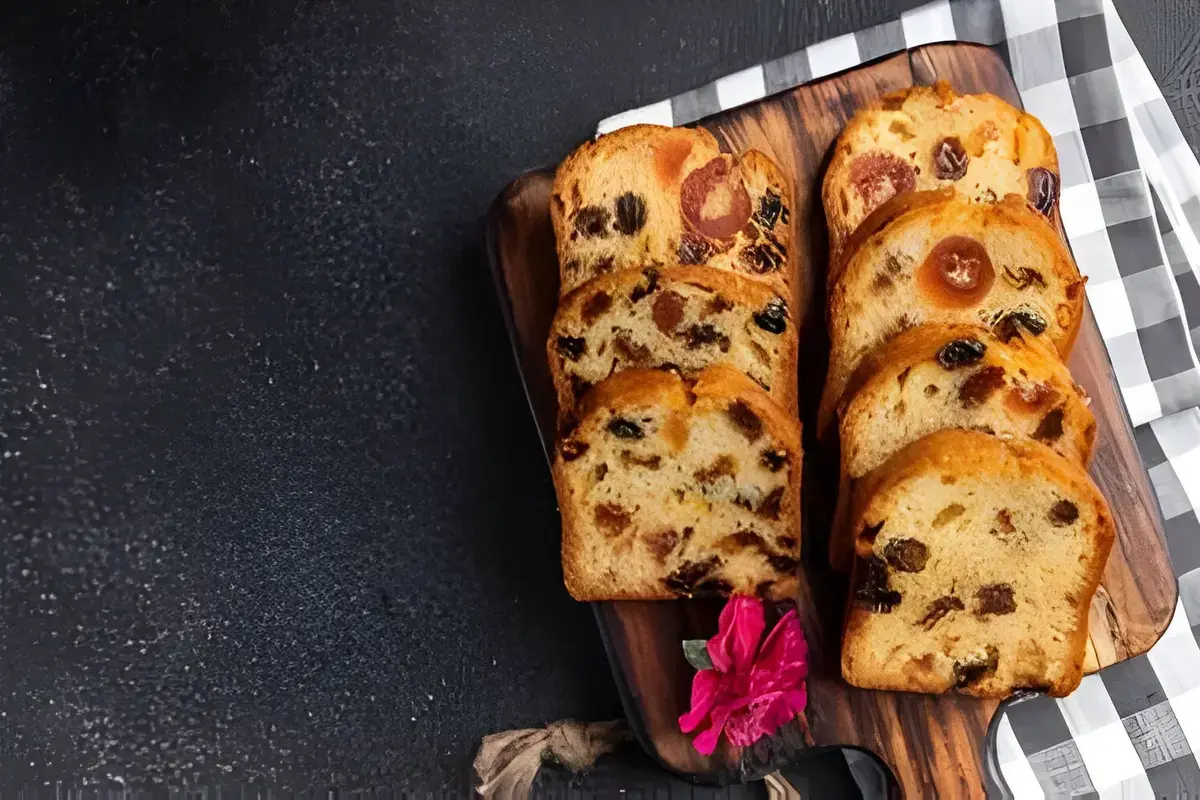Intruduction
The Enduring Appeal of Fruit Cake
Fruit cake, a timeless holiday staple, carries a rich tapestry of history and tradition in every slice. This beloved or sometimes controversial dessert has woven its way through centuries, marking celebrations and festive seasons across the globe. But what is it about fruit cake that evokes such strong feelings?
A Brief History of Fruit Cake
The journey of fruit cake begins in ancient Rome, where pomegranate seeds, pine nuts, and raisins were mixed into a barley mash. Over time, this evolved into the fruit-laden cake we recognize today. By the Middle Ages, honey, spices, and preserved fruits were added, making the cake a symbol of prosperity and celebration.
Why Fruit Cake is a Holiday Staple
Fruit cake’s association with the holidays stems from its rich ingredients and the labor of love required to prepare it. Traditionally made well in advance of Christmas to allow the flavors to meld and mature, this cake embodies the spirit of anticipation and preparation that the holiday season brings. Moreover, its longevity and ability to be shared make it a perfect symbol of generosity and communal joy.
Exploring the Different Varieties of Fruit Cake
Fruit cake, a timeless holiday staple, comes in an array of varieties that cater to diverse tastes and traditions. Interestingly, the distinction between traditional and modern fruit cakes marks a fascinating evolution. Traditional versions, rich in history, often feature a dense mixture of candied fruits, nuts, and spices, all soaked in spirits. On the other hand, modern interpretations embrace innovation, incorporating a wider range of ingredients and flavors to suit contemporary palates.
Moreover, fruit cake’s regional variations highlight its global appeal. For instance, the United Kingdom’s Christmas cake is notably rich and moist, generously laden with dried fruits and marinated in brandy. In contrast, the Caribbean Black Cake, deeply infused with rum and molasses, offers a uniquely intense flavor profile. Meanwhile, Germany’s Stollen, a lighter, bread-like cake, is studded with dried fruit and marzipan, showcasing a different take on the fruit cake tradition.
Furthermore, the ingredients play a pivotal role in defining each variety’s character. While some recipes emphasize the inclusion of exotic fruits and nuts, others might highlight the use of local, seasonal produce. This diversity not only enriches the fruit cake tradition but also invites bakers to experiment and personalize their creations.
How to Make the Perfect Fruit Cake
Making the perfect fruit cake is an art that combines tradition with personal touch. First, let’s focus on the essential ingredients. A classic fruit cake requires a mix of candied fruits, nuts, and spices. These elements provide the signature flavors and textures. Additionally, incorporating dried fruits like raisins, currants, and dates adds depth and richness.
Next, preparation is key. Begin by soaking your dried fruits in rum or brandy overnight. This step ensures they are plump and flavorful. Then, cream together butter and sugar until light and fluffy. This process forms the base of your cake, contributing to its moist texture.
Now, onto the baking guide. After combining your wet and dry ingredients, fold in the fruit and nut mixture gently. Pour the batter into a prepared pan, smoothing the top. Bake at a low temperature for several hours. This slow baking process is crucial for a moist, evenly cooked cake.
Moreover, patience is vital. Once baked, wrap the cake in a cloth soaked in your choice of alcohol. Store it in an airtight container. This aging process allows the flavors to meld and deepen, resulting in a richer cake.
Finally, remember, making fruit cake is more than following a recipe. It’s about adding your unique twist. Experiment with different fruits, nuts, and spices. Adjust the alcohol type or skip it altogether for a non-alcoholic version. The goal is to create a cake that reflects your taste and the joy of the season.
Tasting the Best and Worst Commercial Fruit Cakes
Tasting commercial fruit cakes can be a journey of discovery. To start, setting criteria for evaluation is crucial. Consider flavor, texture, and the balance of ingredients. These factors determine a fruit cake’s appeal. Moreover, the presence of moist, plump fruits and a rich, buttery base often signifies quality.
Firstly, let’s dive into the top picks. Some commercial fruit cakes truly stand out. They boast a harmonious blend of spices, fruits, and nuts. Their moist texture and deep flavors win over even skeptical palates. Brands that prioritize quality ingredients and traditional baking methods often rise to the top.
Conversely, not all fruit cakes hit the mark. Common pitfalls include dryness and an overwhelming use of artificial flavors. Some cakes may skimp on the fruits and nuts, leading to a lackluster eating experience. Identifying these shortcomings helps us appreciate the characteristics of a superior fruit cake.
Furthermore, price doesn’t always indicate quality. Some affordable options surprise with their excellence, while pricier cakes may disappoint. Thus, exploring a range of brands is advisable. This approach allows you to discover hidden gems and determine personal favorites.
The Cultural Significance and Traditions of Fruit Cake
Before we delve into the FAQs, it’s essential to appreciate the cultural significance and traditions surrounding fruit cake. This dessert is not just a holiday treat; it’s a symbol of celebration, history, and global connections.
Fruit cake’s roots run deep. Historically, it began as a way to preserve fruits during winter. Over centuries, it evolved into a festive staple, enjoyed in various forms around the world. Each region adds its unique twist, reflecting local tastes and customs. For instance, in the UK, it’s a Christmas centerpiece, while in the Caribbean, it’s a wedding must-have, soaked in rum and rich with spices.
Moreover, fruit cake symbolizes generosity and prosperity. Giving a fruit cake as a gift during the holidays is a tradition that dates back to the Roman times. It conveys wishes of good health and fortune for the coming year. This act of sharing strengthens bonds and spreads joy among friends and family.
Additionally, fruit cake is a testament to culinary endurance. Its ability to be stored and improve with age makes it a symbol of resilience and patience. This characteristic mirrors the enduring nature of the traditions and relationships it celebrates.
Frequently Asked Questions About Fruit Cake
Fruit cake often sparks curiosity and, sometimes, debate. Let’s tackle some frequently asked questions to shed light on this traditional yet sometimes misunderstood dessert.
How long does fruit cake last?
Surprisingly, fruit cake’s longevity is one of its hallmarks. When stored properly, a fruit cake can last for months or even years. The key is in the alcohol content, which acts as a preservative. For those preferring a non-alcoholic version, using sugar syrup or proper sealing techniques can also extend its shelf life. Remember, the flavors of a fruit cake deepen and mature over time, making it a treat that truly gets better with age.
Can fruit cake be made without alcohol?
Absolutely! While alcohol serves as both a flavor enhancer and preservative, you can certainly make a delicious fruit cake without it. Substitute fruit juice or syrup to soak the fruits. This approach keeps the cake moist and flavorful while making it suitable for all ages and preferences.
What are the best fruits to use in a fruit cake?
Diversity is the spice of life, and this holds true for fruit cakes. Candied cherries, citrus peel, currants, raisins, and dates are classic choices. However, don’t hesitate to experiment with dried apricots, figs, or even tropical fruits like pineapple and mango for a modern twist. The goal is to achieve a balance of flavors and textures that appeal to your taste buds.
Why is my fruit cake dry?
A dry fruit cake often results from overbaking or insufficient moist ingredients. Ensure your recipe includes enough butter, eggs, and soaked fruits. Also, keep a close eye on the baking time and temperature. Wrapping the cake in alcohol-soaked cloths and storing it in an airtight container can also help retain its moisture.
Is fruit cake healthy?
In moderation, fruit cake can be part of a balanced diet. It’s packed with fruits and nuts, which provide essential vitamins, minerals, and healthy fats. However, be mindful of the sugar and alcohol content. Opting for natural sweeteners and reducing the alcohol can make your fruit cake a healthier option.
How can I make my fruit cake more flavorful?
Enhancing your fruit cake’s flavor starts with quality ingredients. Soak your fruits in alcohol or juice well in advance to enrich their taste. Spices like cinnamon, nutmeg, and cloves add warmth and depth. Don’t forget a splash of vanilla extract or almond essence for that extra layer of flavor. Lastly, aging your cake properly allows the flavors to meld and intensify, resulting in a truly delectable dessert.
What are the different types of fruitcake?
Fruit cake comes in a delightful variety, each with its unique characteristics and flavors. The traditional Dark Fruit Cake is rich, dense, and loaded with spices and molasses. Light Fruit Cake offers a milder taste with lighter-colored fruits and less dense texture. Black Cake or Rum Cake, popular in the Caribbean, is known for its dark color and strong rum flavor, achieved by soaking dried fruits in rum for months. The Stollen, a German version, is a bread-like fruit cake with marzipan in the center, dusted with powdered sugar. Lastly, the Panettone, an Italian favorite, is a lighter, brioche-like cake filled with candied fruits. Each type reflects different cultural interpretations of this versatile dessert.
How alcoholic is fruitcake?
The alcohol content in fruit cake varies widely depending on the recipe and the baker’s preferences. Traditionally, fruit cakes are soaked in spirits like brandy, rum, or whiskey, which not only add flavor but also act as preservatives. The soaking process can involve a few tablespoons to several cups of alcohol. However, much of the alcohol evaporates during baking, leaving behind a rich flavor without a high alcohol content. For those who prefer a non-alcoholic version, fruit juices or syrups are excellent alternatives.
Is fruit cake a healthy food?
Fruit cake can be considered healthy in moderation. It is packed with dried fruits and nuts, which are sources of fiber, vitamins, minerals, and healthy fats. However, it’s also high in sugar and calories, especially if alcohol is added. To make a healthier version, consider using whole wheat flour, reducing the sugar content, and choosing natural sweeteners. Additionally, incorporating a variety of nuts and using less candied fruit can increase its nutritional value.
Why are people called fruit cakes?
The term “fruit cake” has colloquially evolved to describe someone who is eccentric or unconventional, much like the dessert itself, which combines a variety of ingredients in a unique and sometimes unexpected way. The expression likely stems from the mixed reputation of fruit cake, which, despite its rich history and cultural significance, has been a subject of humor and disdain for its dense texture and eclectic mix of ingredients. It’s a lighthearted way to acknowledge someone’s quirky or unusual traits, reflecting the diverse and colorful nature of both the dessert and human personalities.
Classic Fruit Cake Recipe
Yield: One 9-inch cake
Preparation Time: 30 minutes
Cooking Time: 2.5 to 3 hours
Total Time: Approximately 4 hours (including cooling)
Ingredients:
- Fruits and Nuts:
- 1 cup raisins
- 1 cup sultanas
- 1/2 cup chopped dates
- 1/2 cup candied cherries, halved
- 1/2 cup candied citrus peel, chopped
- 1/2 cup chopped almonds
- 1/2 cup chopped walnuts
- 1/4 cup dark rum or brandy, plus extra for feeding
- Dry Ingredients:
- 2 cups all-purpose flour
- 1 teaspoon baking powder
- 1/2 teaspoon salt
- 1 teaspoon ground cinnamon
- 1/2 teaspoon ground nutmeg
- 1/4 teaspoon ground cloves
- Wet Ingredients:
- 1 cup unsalted butter, room temperature
- 1 cup brown sugar
- 4 large eggs
- 1 tablespoon molasses
- Zest of 1 lemon
- Zest of 1 orange
Instructions:
- Prep the Fruits:
- In a large bowl, combine all the fruits and nuts. Pour over the rum or brandy, cover, and let soak overnight.
- Prepare for Baking:
- Preheat your oven to 275°F (135°C). Line a 9-inch round cake pan with parchment paper and lightly grease the sides.
- Mix Dry Ingredients:
- Sift together the flour, baking powder, salt, cinnamon, nutmeg, and cloves in a bowl. Set aside.
- Cream Butter and Sugar:
- In a large mixing bowl, beat the butter and brown sugar until light and fluffy. Add the eggs, one at a time, beating well after each addition. Stir in the molasses, lemon zest, and orange zest.
- Combine:
- Gradually fold the dry ingredients into the wet mixture. Then, fold in the soaked fruit and nut mixture until evenly distributed.
- Bake:
- Pour the batter into the prepared pan and smooth the top with a spatula. Bake in the preheated oven for 2.5 to 3 hours, or until a skewer inserted into the center comes out clean.
- Cool and Feed:
- Allow the cake to cool in the pan for 15 minutes, then turn out onto a wire rack to cool completely. Once cool, prick the surface with a skewer and slowly spoon over a few tablespoons of rum or brandy.
- Store:
- Wrap the cake in parchment paper, then in foil, and store in an airtight container. Feed the cake with a tablespoon of alcohol every two weeks until you’re ready to serve.
Serving Suggestions:
Serve slices of fruit cake as is, or with a dollop of whipped cream or a side of custard for an extra indulgent treat.
Note:
This fruit cake improves with age, so consider making it a few weeks in advance to let the flavors develop fully.
Finally, Enjoy your baking, and may this Classic Fruit Cake bring warmth and joy to your table!



